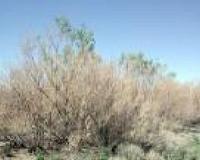 |
New Orleans LA (SPX) May 25, 2011 The next agricultural revolution may be sparked by fungi, helping to greatly increase food-production for the growing needs of the planet without the need for massive amounts of fertilizers according to research presented today at the 111th General Meeting of the American Society for Microbiology in New Orleans. "The United Nations conservatively estimates that by the year 2050 the global human population is expected to reach over 9 billion. Feeding such a population represents an unprecedented challenge since this goes greatly beyond current global food production capacity," says Ian Sanders of the University of Lusanne, Switzerland, speaking in a session entitled "How Microbes Can Help Feed the World." Sanders studies mycorrhizal fungi, a type of fungus that live in symbiosis with plant roots. When plants make symbioses with these fungi they tend to grow larger because the fungi acquire the essential nutrient phosphate for the plant. Phosphate is a key component of the fertilizers that fueled the Green Revolution in middle of the 20th century that made it possible then for agriculture to keep up with the growing global population. "In most tropical soils plants have enormous difficulty in obtaining phosphate and so farmers have to spend a huge amount of money on phosphate fertilizer. Farmers have to add much more fertilizer than in temperate regions and a very large amount of the cost to produce food is the cost of phosphate," says Sanders. Phosphate reserves are being rapidly depleted. Increasing demand for the nutrient is driving up prices and some countries are now stockpiling phosphate to feed their populations in the future, according to Sanders. While mycorrhizal fungi typically only grow on the roots of plants, recent biotechnological breakthroughs now allow scientists to produce massive quantities of the fungus that can be suspended in high concentrations in a gel for easy transportation. Sanders and his colleagues are currently testing the effectiveness of this gel on crops in the country of Colombia where they have discovered that with the gel they can produce the same yield of potato crop with less than half the amount of phosphate fertilizers. "While our applied research is focused on Colombia it could be applied in many other tropical regions of the world," says Sanders.
Share This Article With Planet Earth
Related Links American Society for Microbiology Farming Today - Suppliers and Technology
 First analysis of invasive plant impacts worldwide
First analysis of invasive plant impacts worldwideLondon, UK (SPX) May 25, 2011 This week the scientific journal Ecology Letters has published a synthesis of the ecological impacts of invasive plants worldwide. This global analysis has been based on more than one thousand studies that in total describe the impacts of 135 invasive plant species. The lead author, Dr. Montserrat Vila, a professor at the Spanish Higher Research Council (CSIC) adds: "This assessment would hav ... read more |
|
| The content herein, unless otherwise known to be public domain, are Copyright 1995-2010 - SpaceDaily. AFP and UPI Wire Stories are copyright Agence France-Presse and United Press International. ESA Portal Reports are copyright European Space Agency. All NASA sourced material is public domain. Additional copyrights may apply in whole or part to other bona fide parties. Advertising does not imply endorsement,agreement or approval of any opinions, statements or information provided by SpaceDaily on any Web page published or hosted by SpaceDaily. Privacy Statement |